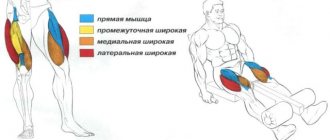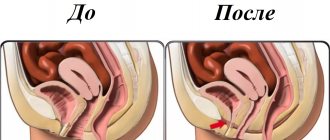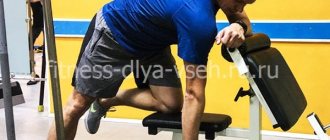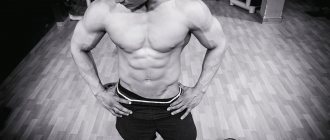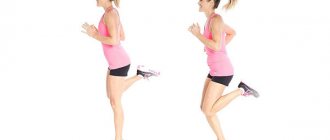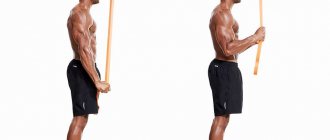Biceps are as simple as five cents
From a biomechanical point of view, when the arm is flexed, the biceps brachii muscle becomes fully tense. That is, there are no special movements to tension the inner or outer head of the biceps. And there are no special exercises to create a biceps peak like the legendary Arnold Schwarzenegger.
The shape of the hand is a genetically determined factor. The peak of the biceps is either present and clearly defined, or it is weakly expressed or absent altogether. You just have to come to terms with this. In any case, well-developed arms look great regardless of their genetically determined shape.
The most important thing is that developing them is not difficult if you do it wisely both from the point of view of physiology and the training process.
How to get peak biceps
The biceps is a relatively small muscle in the human body and is quite easy to develop. First of all, you need to understand that there is absolutely no point in focusing on the biceps. This is tantamount to pumping up the abs in order to achieve six-pack abs for an overweight person. That is, in order for the abs to be visible, you should reduce the amount of fatty tissue throughout the body, and this can be done faster with exercises that contribute to this best.
It's exactly the same with biceps. By intensely training your biceps, you will not be able to increase them, at least it will not be as effective as working on increasing muscle mass. When using this approach, volumes will increase and, accordingly, the volumes of hands too. Such exercises are basic.
- Firstly, when performing heavy multi-joint exercises, the entire mechanism aimed at hypertrophy of muscle fibers is launched.
- Secondly, when performing them, the muscles of the arms are involved. Also, to get the best biceps peak, you need to use other muscles of the arm, namely the brachialis.
The brachialis is a small muscle that is located under the biceps brachii muscle. With the development of brachialis, the shoulder becomes more aesthetic, voluminous, and due to the additional volume, the biceps “rises,” thereby increasing its peak.
In addition to basic exercises, to develop the peak of the biceps, you need to use several isolation exercises.
What factors cause muscle growth?
Before moving on to the exercises, let's look at the main factors of muscle growth. This is necessary for a clear understanding of the appropriateness of the exercises that we will consider below.
To simplify it as much as possible, muscle development requires building material (amino acids), energy (glucose), hormones (the body synthesizes them in response to training stress) and muscle tension or tension, which initiates growth. Moreover, sufficient muscle tension is the main factor , without which there will be no progress, even if the accompanying conditions are met.
Accordingly, for effective development of muscles, including biceps, it is necessary to create conditions in which there is noticeable muscle tension without unnecessary stress on the ligaments and tendons. This is achieved by using the correct technique for performing the exercise and understanding its biomechanics.
In the case of the biceps brachii muscle, for example, the grip width of the barbell during a classic biceps curl does not matter. Let me remind you that with any bending of the arm, both heads of the biceps are always tense. Thus, the grip should be comfortable to maximize muscle tension with minimal stress on the hands and elbows.
This is much more effective than trying to pump up the outer and inner heads of the biceps separately by varying the grip width. You will spend more time, and due to a grip that is too wide or too narrow, you will overstrain your joints and ligaments, which will not allow you to create sufficient muscle tension. Progress in increasing the weight, and therefore adapting the muscle to the load through its growth, will stop before the size of the biceps begins to please you.
Biceps anatomy
The biceps, or biceps brachii muscle, consists of two bundles - the short and long heads of the biceps. The muscle is located along the humerus and serves mainly as a flexor of the shoulder and forearm. The long head, also known as the outer head of the biceps, is located towards the outside of the shoulder. Both heads of the biceps are involved in all curl exercises, but each exercise involves one or the other head of the biceps muscle differently. Likewise, the short one - the inner head of the biceps, located closer to the inside of the shoulder, is responsible for the convex shape and is involved in flexing the arms and forearms.
There are several ways to train and equipment for biceps: machines, benches, barbells and dumbbells. In each set of exercises, both the short and long heads of the biceps must work, otherwise you will not achieve the desired proportions and desired results in growth. Therefore, the anatomy of the arm muscles will allow you to competently apply exercises in practice, with an understanding of which muscles you are working on.
The most effective exercises for developing biceps
There are only five of them, and in reality three will be enough. Additional exercises are only needed to diversify the training process.
In fact, to effectively develop the biceps brachii muscle, having a barbell and a pair of dumbbells is enough. But you can, in principle, get by with just one barbell and train large biceps with one exercise. Let's start with him.
Barbell Curls (Biceps Curls)
The favorite exercise of all young guys who have just reached the gym, along with the bench press. And both of these exercises are usually done incorrectly, which negates any progress.
The main mistake is that the elbows are brought forward , and this cannot be done. The elbows should remain in place, as shown in the video above. In this case, the load falls only on the biceps brachii muscles, and there is no moment of their relaxation in the peak position.
If your elbows are under the barbell, the load will go into them (the force vector is directed downward), and the biceps will relax. Naturally, there is no talk of peak reduction. It is impossible to do it in this position.
As for the grip, grab the bar approximately shoulder-width apart so that your hands do not bend in the horizontal plane. In addition, do not bend your hands towards yourself at the top position of the barbell. They always remain in the same position.
Having raised the barbell to the top position, hold for 0.5 seconds, “squeezing” the muscle into peak contraction. When lowering the projectile down, do not relax your arms and do not fully extend them.
I also recommend using a curved bar, which will allow the hands to be in a natural position, turned inward at about 45°. This practice will prevent them from overexerting themselves as the weight increases.
Types of exercises
In bodybuilding, it is customary to divide exercises into basic, that is, general developmental, and isolating, for a specific part of the body.
As a rule, for each muscle group there are approximately equal numbers of isolation and compound movements. But for every rule there is an exception. And this exception is the biceps brachii muscle.
The fact is that there are only 1-2 really basic movements for biceps. The remaining exercises are exclusively isolating.
In basic exercises, 2 joints and above (also called multi-joint) and a large number of muscles are simultaneously involved in the work.
By this definition, only pull-ups on the bar with a reverse grip are considered basic biceps exercises.
Here two joints are involved in the movement - the shoulder and elbow. And in addition to the biceps, the latissimus dorsi muscles, forearms and shoulders are tensed.
To pump the biceps as efficiently as possible, the torso is held vertically, trying to pull itself up by bending the arms.
There is also a reverse grip pull-up technique with an emphasis on the lats. In this case, the torso is tilted back, bringing the chest forward and bending in the lower back. Stretch your chest towards the crossbar. In this case, the biceps receives a secondary load.
If your level of physical fitness does not allow you to do pull-ups on the bar, you can start building large biceps with a similar exercise in the Gravitron simulator.
Another multi-joint biceps exercise in the machine is the reverse-grip lat pull-down to the chest. This exercise imitates the same pull-ups, but is much easier to perform. In terms of impact effectiveness, it is an order of magnitude weaker, but is suitable for beginners or as a “finishing” movement for more experienced athletes.
Experienced bodybuilders rarely use such exercises to pump up their biceps. Their programs for this muscle consist exclusively of single-joint isolation movements. But this does not mean that beginners need to take the schemes of professionals as a basis.
At the initial and middle stages of training, the emphasis is on basic exercises that stimulate maximum production of hormones necessary for growth. This also applies to the biceps.
Isolation exercises are performed using only one joint (single-joint) and a minimum number of muscles.
All the variety of biceps movements, with the exception of those listed above, are isolating.
Even lifting a barbell or dumbbells for biceps while standing is called basic only conditionally. After all, in this case only the elbow joint works. And the muscles that join are the forearms.
As for other isolation exercises, pumping up biceps with their help is quite problematic.
Options with a barbell and dumbbells can stimulate growth, but are much weaker than the real “base”. Movements on blocks and exercise machines have even less effect on increasing volumes.
Isolation is designed more for “polishing” the muscles. That is, a more detailed study of existing volumes.
Lifting dumbbells for biceps while sitting on an inclined bench
An exercise as effective as PSHNB and complements it well on arm day.
The tilt angle of the bench is 45°. The main condition for performing the exercise correctly is keeping the elbow in place when lifting the dumbbell for the biceps .
The biomechanics of the movement are exactly the same as in the biceps curl. When the elbow remains in place, the entire load falls on the biceps brachii muscle and peak contraction can be achieved.
By bringing the elbow forward and actually placing it under the dumbbell, all the load goes from the biceps to the joint. The biceps muscle relaxes, peak contraction is impossible, and muscle tension is completely lost.
To place your elbows in the correct position, just sit on a bench and simply lower your arms with the dumbbells down. This is the starting position and the elbows should remain in this position throughout the entire exercise.
The technique of execution is for the most part similar to that in PSHNB: peak contraction at the top, do not relax your arms at the bottom. You can raise both hands together, or alternately. In the latter case, keep the “resting” arm slightly bent, maintaining slight tension in it.
The difference from PSHNB is only in the supination of the hands. That is, in the lower position the dumbbell is parallel to the body, in the upper position the hand turns outward.
Basic biceps exercises
Everyone is accustomed to considering multi-joint exercises as basic exercises.
As an example, let's take the classic bench press or squats with a barbell. But full isolation cannot be achieved when bending the elbow, so lifting barbells and dumbbells for biceps is also considered basic.
We lift the barbell for biceps while standing
This is the simplest exercise that perfectly increases the volume of your arms. The only drawback is the serious stress on the wrists and radial ligaments. In order to reduce the risk of injury, it is recommended to use an EZ bar .
Technique:
- Place your feet shoulder-width apart, place your feet parallel, point your toes to the sides;
- Hold the bar tightly, look forward;
- As you inhale, without jerking, bend your arms and lift the apparatus to your chest;
- Pause slightly at the top, exhale freely and lower the bar.
Helpful Tips:
- The body should remain straight and should not sway;
- Elbows should be placed at the sides and no longer move them during the entire approach;
- Forget heavy weights and cheating.
Raising dumbbells for biceps
The exercise is almost the same as the previous one, only the equipment and the increased load on the forearms are different. Professional bodybuilders are able to better contract muscle fibers using dumbbells.
Technique:
- Grasp the apparatus, take a deep breath and bend your elbows;
- Turn your hands outward at the moment when your forearms are parallel to the floor;
- Exhale deeply and slowly lower the weights.
Useful tips:
- The elbows remain motionless, thanks to this the exercise will become more effective;
- Try not to cheat in order to achieve the desired results faster.
Exercise "Hammer"
The exercise develops the brachioradialis muscle, making the biceps voluminous and prominent.
Technique:
- Stand on the floor, back straight, take dumbbells in your hands, palms should be turned towards the body;
- Raise each projectile in turn to shoulder level;
- Remember to breathe properly throughout the set.
Helpful Tips:
- Don't rock your body;
- Lift dumbbells without jerking;
- Bend your arms only at the elbows.
Hammer Grip Dumbbell Curls
This exercise is mainly aimed at developing the small muscle between the biceps and triceps - the brachialis .
It gives the arm a more impressive, athletic shape, so to speak, increases its thickness and has a good effect on the development of overall strength of the shoulder and forearm.
We perform the exercise standing, shoulder blades retracted, elbows held in a natural position at body level, do not move forward, perform a peak contraction at the top, do not relax the arms at the bottom.
You can raise both arms at once or alternately, without fully extending them at the bottom. In the latter case, we maintain a slight tension in the “resting” hand.
Standing dumbbell curl
An alternative to doing dumbbell curls while sitting on an incline bench.
The technique of performing the exercise is similar to that of lifting dumbbells for biceps with a “Hammer” grip, but there is supination of the hand in the upper position.
The shoulder blades are brought together, we keep the elbows at body level, we don’t move them forward, we do a peak contraction at the top, and we don’t relax the arms at the bottom.
You can raise both arms at once or alternately, without fully extending them at the bottom. In the latter case, we maintain a slight tension in the “resting” hand.
Other exercises for the gym
You can find out how to do a dumbbell press on an incline bench here. Exercise for triceps - standing French press. The lunge exercise for the buttocks and thighs is described at this link. For those who are not good at pull-ups, read about Australian pull-ups. Incline crunch exercise, here. and Technique for performing concentrated biceps curls.
If you want to pump up your biceps in the gym, 1 targeted workout per week is enough. As an option:
- lifting dumbbells;
- lifting the bar;
- practice on the Scott bench (9-12 repetitions).
Biceps exercises performed in the gym are done in a circle in 4 sets. Rest between them is half a minute. It is not recommended to dilute the complex with other techniques. Ideally, it is better to include the block in the main program, limiting it to the recommended number of takes of 3 sets.
The arms swing great on the horizontal bar. The advantage of the technique is the simultaneous pumping of 6 muscle groups: brachialis, forearm, biceps, abdominal muscles, back and chest. Pull-ups are combined with all types of loads and serve as a basic or additional exercise.
Working in a biceps machine
Another alternative to the classic biceps curl. Often people prefer this particular exercise, considering it more effective, since they “feel the muscle” in it better.
In fact, we are talking only about rigid fixation of the elbows and a clearly defined amplitude, which does not provide freedom in movement for performing the exercise incorrectly. If you perform PSNB with the technique described above, you will feel the muscle just as well.
However, there are a few important rules when working with a biceps machine. So, the shoulder should lie completely on the pillow, avoid just resting on the elbows. To do this, select the desired seat height.
In addition, do not fully extend your arms, maintaining tension in them. In the top position, do not bend your hands towards yourself; they remain straight all the time.
How to train biceps
The biceps is a small muscle, but actively works in almost all deadlifts as a synergist. That is, it helps the back muscles, for example, in pulling a barbell to the stomach or pulling a block to the chest. Accordingly, it is easy to overtrain if this factor is not taken into account. In a permanently overtrained state, naturally, nothing will grow.
For the effective development of any muscle group, it is advisable to give it enough time to recover, and then load it with a certain frequency. On average, recovery time ranges from 48 to 72 hours.
In the case of biceps, an excellent option is when in one workout in a weekly microcycle they are loaded only as synergists, and in the second there is a separate arm workout with a couple of exercises directly on the biceps muscle.
There are actually a lot of schemes, both for a 3-day split and for a 4-day one. It is important to understand the principle itself, which I will describe using the example of a microcycle below.
DAY 1: Back + Triceps DAY 2: REST DAY 3: Legs + Shoulders DAY 4: REST DAY 5: Chest + Biceps DAY 6: REST DAY 7: REST
On the first training day, the biceps works as a synergist in back exercises (plus the rear delta), while the triceps are fully pumped.
On the second training day, we load our legs and shoulders to give our arms a good rest.
On the third training day, the triceps work as a synergist (plus the anterior deltoid) in chest press exercises, and the biceps are trained fully (PSNB + seated dumbbell lifts + Hammer). Thus, the arms are worked out twice a week and still have time to recover well.
As for the training protocol, vary the number of repetitions in biceps exercises from 8 to 15, and the number of approaches - up to three working sets. Don't forget about a good warm-up, gradually increasing the load and cycling. You can read about this in detail in the feature article.
Exercise Technique
Zottman Curls
Zottman curls are great for warming up the muscles before pumping up the biceps. This exercise will thoroughly warm up your biceps, as well as your shoulders, forearms and elbows.
You shouldn't take a lot of weight here. Perform each repetition with light weight and slowly. This movement works your biceps, gets blood flowing to the target muscles, and prepares your elbows for a harder workout.
Begin to curl your arms while lifting the dumbbell. Once you reach the top point, rotate your wrists so that your palms face forward, thereby holding the dumbbell with a pronated grip. Lower the weight. Once you reach the bottom point, rotate your palms back to the starting position with your palms facing forward.
Rest 1 minute between each set.
Thick Barbell Lift
A thick bar develops the muscles of the forearm and biceps better than any other barbell. It causes the biceps muscles to contract more strongly. Clutching a thick bar in your hands will prevent you from lifting too much weight.
Large barbell curls will allow you to perform unique drop sets. Perform barbell raises to failure. And then remove the attachments from the bar and perform at least two more lifts with a regular barbell, again until the muscles fail. Choose the right weight to achieve muscle failure within the set number of repetitions.
Superset: Incline Dumbbell Raises and Seated Hammers
Supersets are the most effective biceps exercises in the gym, where you spend minimal time moving from one movement to the next. With this combination you won't have to move at all or even change your weight.
Start by lifting dumbbells with your back pressed against an incline bench. As soon as you reach muscle failure, squat down, change the position of your hand and immediately begin the “hammer” exercise. It is much lighter than incline raises, so there is no need to change the weight even after reaching muscle failure.
Another tip for effectively pumping up your biceps: When you begin the hammer exercise, grip the dumbbells with your palm facing your body. This will allow more muscle fibers to be recruited, which will stimulate biceps growth.
Lower Block Arm Curl
Crossover exercises will be the defining touch in building your biceps because the tension on your muscles will be maintained throughout the reps. This is an isolation exercise, so you won't have to use a lot of weight to get your biceps working.
For those unfamiliar with the 21 rep method, it involves 7 half reps at the bottom, 7 half reps at the top, and 7 full reps. If you stand stable (i.e. no body sway), your biceps will start to burn.
For an extra shake-up, also perform lying bicep curls. Lying on your back means you won't be able to use momentum and your biceps will work that much harder to the finish.


